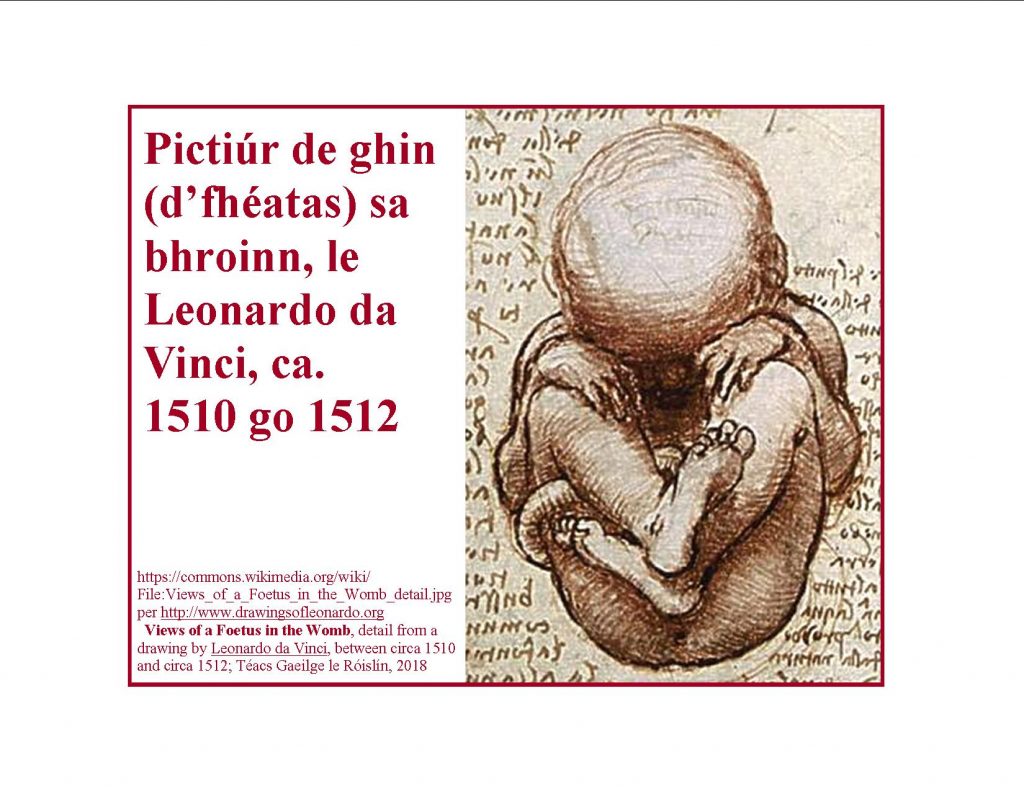The Irish phrase for “breech birth” (yet another use of the Irish word ‘tóin’) Posted by róislín on Jul 23, 2018 in Irish Language
(le Róislín)
About 20 years ago, before the ease of using online dictionaries, I remember hunting high and low for the Irish for “breech birth.” I recently noticed the phrase included in focloir.ie and thought it might be of interest for this blog.
There are at least three ways to express the concept. One is literally a phrase for “breech birth” (or “breech delivery”) and the others are more like saying “feet first” or “towards the backside.”
The more technical phrase is “breith tóna.” Quite straightforward, “breith” meaning “birth,” and “tóna” meaning, well, “of backside,” from “tóin.” “Tóin” is probably more well known from the phrase “póg mo thóin.” The phrase “breith tóna” is also interesting in that it’s much less euphemistic than then English. In English, “breech” is a fairly old-fashioned word for “backside,” “posterior,” or “bottom,” or whatever you want to call it. In everyday modern English, it’s mostly limited to specialized phrases such as “breech-clout” or “breech-cloth,” or to phrases with extended meanings, like “riding breeches” or “to be too big for your breeches” (britches). How did types of trousers end up being called “breeches”? Apparently because they cover one’s bottom. “Breech” singular is “backside,” or I guess if one were talking about a number of people in this slightly archaic style of English, one could use “breeches” in the plural for “backsides,” but normally the plural (breeches) is the garment or covering.
A second way to say that someone was born in a breech delivery is “in aghaidh na gcos,” lit. in the face of the feet,” that is “feet first.”
A third way to say that someone was born in a breech delivery is “rugadh i leith a thóna é” for a male child or “rugadh i leith a tóna í” for a female child. I don’t know if it’s even physically possible to have two or more babies born breech, but if it is, the phrase would be “rugadh i leith a dtóineanna iad.” In my limited understanding of how this works, I think it’s common for one twin to be headfirst and the other starts out foot first, but after the headfirst is born, the second twin might turn to also be headfirst. Of course, many breech births these days are actually delivered by “gearradh Caesarach,” lit. “Caesarean cutting,” so I think it’s very unlikely that there would or could be two breech births in one presentation. Eolas ag aon obstatraí (cnáimhseoir) ar an liosta seo?
BTW, the question might arise, is there an abbreviation for “gearradh Caesarach” the way “c-section” works for “Caesarean section”? Not that I can find. So far, I haven’t seen any usage of “c-“ as a prefix, leniting “gearradh” to “ghearradh,” although there are precedents for such structures in Irish, like “c-bhanda” in astronomy or “c-sheastán” in film-making. Putting a “-c” after “gearradh” would seem even more unusual to me (remember, we say “t-léine” in Irish, not “léine-t,” fad m’eolais, though I have seen “leine-t” for Scottish Gaelic). However I have found one very technical example of a final “-c” in the phrase “ocsaíodáis chiteacróm-c” (cytochrome-c oxidase). Not that I’m likely to use that i ngnáthchaint. At any rate, I don’t see any examples of an abbreviated form of “gearradh Caesarach” in Irish.
There may be more ways to say “breech birth,” in Irish , but these are what I have found so far.
Although I haven’t found the exact combination online, “suíomh tóna” would seem to work for “breech presentation,” since “suíomh” can refer to a baby’s position in the womb before birth. That’s in addition to its various other meanings like “setting,” “location,” “site,” “position,” or “situation,” all based on “suí” (sitting, to sit).
A final point about all of this is that there are at least three types of breech birth, and so far, I haven’t found formal distinctions for these in Irish. There is “frank” or “extended” breech, with the legs straight up by the ears. Possibly this could be called “sínte” but that’s just my guess. There’s also “complete” or “flexed” breech (iomlán or fillte?), with the leg crossed – sounds the most difficult to me. And then, a term I love, “footling” when the baby literally comes “foot first,” mostly limited to premature babies. Maybe the Irish terms are making a distinction, since one says “towards the backside” and the other says “in the face of the legs” but the definitions are all just generically “breech birth.”
Well, I hope you found this of interest. Even if you don’t have much reason to discuss breech births, it’s at least one more example of using the word “tóin” in the genitive case, singular, (tóna) and the plural (tóineanna). SGF — Róislín

Build vocabulary, practice pronunciation, and more with Transparent Language Online. Available anytime, anywhere, on any device.





Comments:
Bob:
Why do you repeat words. Todays word of Inne’ (yesterday) was also January 20, 2018 word of the day.
róislín:
@Bob Bíonn daoine nua ag tosú i gcónaí. Seans maith nár léigh siad an t-iarFhocal an Lae. Ach ní dóigh liom go raibh aon athrá i gceist le hábhar an bhlag inniu. Is rudaí éagsúla iad an blag agus an “Word of the Day.”
Muireann:
Are there any sean fhocail’s or sayings in relation to the life of the lucky person to survive breech birth?🤔
Do they go on to be successful etc?